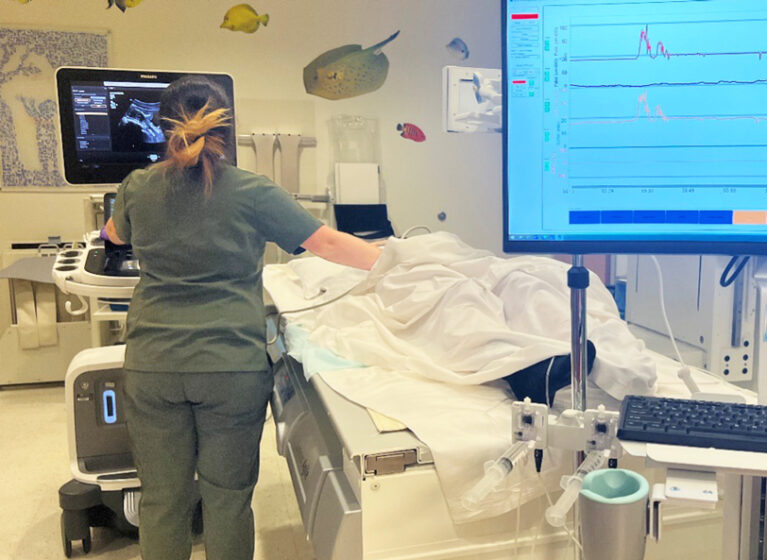
Video urodynamic studies (UDS) are a routine part of care for children born with spina bifida to study bladder function. Traditionally, these studies have relied on fluoroscopy, which requires X-ray imaging. A new technique, pioneered at UVA Health Children’s, uses contrast-enhanced voiding ultrasound (ceVUS) instead. And clinical trials show many benefits.
Diagnostic-wise, the contrast ultrasound appears as effective as X-ray imaging but avoids radiation. An added benefit is positive reactions from parents. They appreciate the lack of radiation exposure and the comfort aspects as well.
“We have patients come in after being part of the initial clinical trial and ask specifically for the ultrasound test with urodynamics because they see the benefits, mainly lack of radiation,” says Nora Kern, MD, the UVA Health pediatric urologist who led the clinical trials.
Urodynamics Important but Stressful for Spina Bifida Patients
For the first years of life, spina bifida patients may need UDS as frequently as every 3-6 months to monitor bladder function. For children this young, the repeated radiation exposure is a measured risk. While no one wants their child to have more exposure than necessary, monitoring bladder health and function is necessary for the child’s long-term kidney health.
But for these children’s parents, the radiation from repeat X-ray exposure is only one of many anxiety-inducing things about the appointment.
For parents, there’s also the inability to be close enough to their children to comfort them. For young children, an X-ray machine can be intimidating. Parents are encouraged to be present, and help their children hold still, but they need to wear a lead apron for their safety and cannot physically be under the X-ray machine. Ultimately, it’s often an uncomfortable and traumatic part of these families’ lives.
Major Benefits of Contrast Enhanced Ultrasonography
In 2020, Kern and the UVA Health Children’s pediatric urology and radiology team started actively trialing the ceVUS modality in conjunction with UDS, which uses an FDA-approved contrast material. In their study, they found that they were able to diagnose pathologies just as effectively with the ultrasound imaging compared to X-ray imaging.
“The imaging quality is quite comparable with the added benefit of continuous imaging, whereas you can’t continuously image an entire UDS study with X-ray due to the radiation,” Kern says.
But in addition to losing the radiation, ceVUS was better received by parents.
A second pediatric urology study by Kern showed families’ reaction was overwhelmingly positive. Over 90% preferred the ceVUS experience for their child compared to X-ray. During ultrasound, parents can be right beside their child through the procedure, lead-apron free, and without bulky equipment between them.
To further reduce trauma, UVA Health Children’s employs Child Life experts to offer parents information before the procedure, and they stay in the room to help occupy and calm the child.
CeVUS Offers Better Experience
The contrast needed for ceVUS was first approved by the FDA in 2015. Since then, many studies have demonstrated that ultrasound with contrast can offer clear images for diagnostics without the negatives of X-ray. UVA Health Children’s offers the first experience with ceVUS in conjunction with UDS.
Overall, ceVUS allows for real-time and continuous diagnostics. If any anatomical changes occur during the study, the ceVUS can actively capture that moment. And, for families, the study offers a better experience with less anxiety.
“Right now, we have about 75 patients or so,” Kern says, reflecting on her current ceVUS study. With the positive results, it’s a service that we expect to continue to offer for patients.